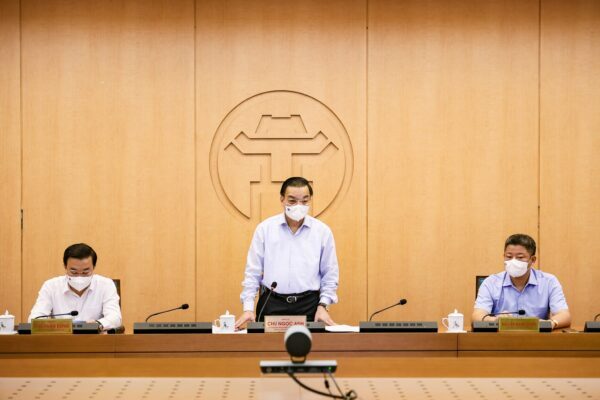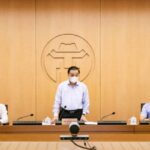Can Kiem commune (Thach That district) is a semi-mountainous area consisting of hills, lowland fields, deep rivers, soil developed on laterite, giving Can Kiem a beautiful natural landscape appearance.
Coming to Can Kiem, the first impression is the peace and quiet in the village. The commune has 6 villages. At the center of Yen Lac 1 village, the image of a 9-root banyan tree more than 500 years old is planted in front of Yen Lac communal house. Common people still say that when making Yen Lac communal house (in the year of Hong Duc 1469), Yen Lac people planted a banyan tree in front of the communal house and right next to the Tich Giang river wharf. Over the years, the tree’s roots hang down to the ground to create many new roots and become a 9-root banyan tree. The banyan tree is attached, imprinting the memories of many generations of local people. The banyan tree is considered a sacred object to protect the villagers from natural disasters and weather, to bring a happy and prosperous life. The banyan tree is about thirty meters high, consisting of 9 large and small roots, winding, luxuriant branches and leaves casting shadows on a large space. Banyan tree is an ideal resting place for villagers after hard working days. The banyan tree was completed by Can Kiem commune to request recognition as a heritage tree.

The 9-root banyan tree is an ideal resting place for villagers after hard working days.
Photo: danviet.com.vn
Yen Lac communal house is located on a high mound overlooking the Tich River. In front of the communal house, there are a couple of elephants in service, made of laterite – a material available in Can Kiem. This is a rare local sculpture. Yen Lac communal house has an architecture in the type of Nhi script, including a great house and a harem. The communal house worships three deities: Trung Cong, Hoang Cong and Dung Cong – generals of Tan Vien Son Thanh, who helped the 18th Hung King fight the enemy to protect the land of Van Lang. The communal house also worships Nguyen Kinh, a famous mandarin of the Mac dynasty, born in Di Nau commune, Thach That district. In Yen Lac communal house, there are still many valuable ordinations from the reign of King Tu Duc; many artefacts in the Nguyen Dynasty, such as 4 sets of palanquins, 2 double and single incense, etc. With its location close to the Tich river, Yen Lac communal house is a unique architectural and landscape highlight. Along with the banyan tree, the communal house, Yen Lac 1 village also has an ancient water well that is clear and cool all year round. In the past, villagers used to take water from the well to serve their daily needs. The people of Yen Lac 1 have protected the cultural space of the village with banyan trees, water wharf, communal yard, ancient well as the cultural quintessence of the ancient village.
Can Kiem people are also very proud when Uncle Ho came to live and work here from January 13 to February 2, 1947, at the thatched house owned by Mr. Nguyen Dinh Khue in Lai Cai hamlet, Phu Da 2 village. During 19 days in Can Kiem, Uncle Ho and key cadres of the Party and Government met to discuss and decide on important national affairs. Here, Uncle Ho wrote a letter to congratulate the Vietnamese compatriots and soldiers in the South (January 24, 1947), a Letter to the capital’s suicide soldiers (January 27, 1947), and a Letter to the soldiers of the National Guard, Self-Defense Force and National Militia, etc.
In 1974, the Party Committee and People of Can Kiem commune restored the old house owned by Mr. Khue into Uncle Ho’s memorial house. The memorial house is located in a small alley; its campus is about 300m2 wide with a simple thatched house, laterite gate, clay yard. In the Memorial House, the nave is the place where Uncle Ho’s statue, agarwood top, and incense bowls are placed for local people and visitors to burn incense to commemorate him. The remaining booths are used to display documents and memorabilia associated with Uncle Ho’s time staying and working here… The memorial house is always cherished and preserved by the local Party committees, authorities and people.

Uncle Ho’s memorial house in Can Kiem – A place of revolutionary traditional education for the young generation.
Can Kiem was not only chosen by Uncle Ho as a place to stop, but also a land rich in the tradition of revolutionary struggle. On March 11, 1953, at the slope of Nua mountain, Can Kiem commune, an extremely fierce hand-to-hand battle took place between our army and the French colonialists. Although the force was too disparate, our army only had 11 men, the soldiers were still determined to hold on, fight for each grove of trees and mountain peaks, and fight to destroy the enemy to the last bullet. To remember the merits of the heroes and martyrs, in 1983, Thach That District Party Committee issued a resolution to build a monument “Martyrs” at Nua Mountain. Nua mountain is located in Phu Da village 1.
From the foot of the mountain, follow the laterite steps leading up to the top of the mountain is the monument “Martyrs”. The monument has a height of 5.5m, a width of more than 2m, made of reinforced concrete, a rectangular tower, on the top embossed with a red flag with a yellow star and the words “To quoc ghi cong”. The statue’s pedestal is 2m high, above are statues of three soldiers of 1.7m tall who are in a position of decisive victory, ready to fight to protect their homeland and country. The two sides of the statue’s pedestal are two relief paintings built with sand and lime material, depicting our soldiers and guerrillas fighting against the enemy.
Nua mountain monument is built on a high pine hill, beautiful terrain, green trees all year round, convenient transportation, located near the relics of Tay Phuong pagoda, Uncle Ho memorial house, etc. is a highlight in the cultural tourism complex – revolutionary history of Thach That district, attracting a large number of visitors. Every year, on holidays, anniversaries, Lunar New Year, all levels of Party committees, authorities and people in Can Kiem commune in particular, Thach That district, in general, all go to Nua Mountain Monument, Uncle Ho’s Memorial House to commemorate the merits of Uncle Ho and heroic martyrs who heroically sacrificed for the homeland. The landmark of Nua mountain, Uncle Ho’s memorial house became a red address, a place to educate profound revolutionary traditions for the young generation, etc.
Can Kiem today is continuing to uphold the criteria of a new rural area, linking the construction of a new countryside with the implementation of a civilized lifestyle, preserving and promoting historical values, traditional culture, and village cultural space.
Mai Phuong

